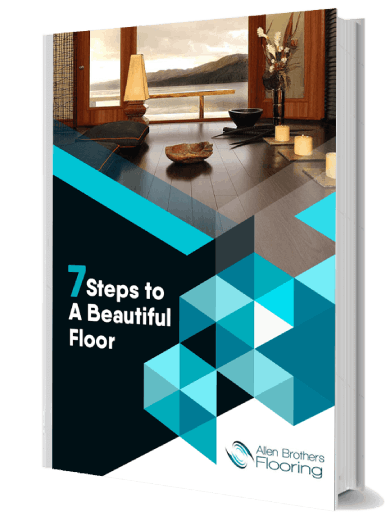
Flooring Tips
Choosing the right flooring for your home upgrade project has never been simpler with our detailed decision guide.
When you’re looking for an economical yet stellar looking flooring system to upgrade your home, hybrid and laminate are two options that rise to the top in most conversations. Yet many people confuse the two as the same, when they are definitely different from one another in benefits, construction, and style.
It’s important that you have the facts straight when it comes to these two flooring types so you can make the right choice for your home. That’s why we’ve put together this handy decision guide so you can truly compare hybrid vs. laminate flooring. You just might be surprised by some of the differences.
Let’s start with some basic definitions…
If you want to learn more about hybrid flooring, check out our other resources:
1. How much does hybrid flooring cost?
2. What are the best hybrid flooring brands?
3. Pros and cons of hybrid flooring
4. Hybrid vs laminate flooring
6. How long does hybrid flooring last?
Laminate flooring gets its name from the top image layer that is literally laminated, or overlaid, onto a base product.
In this case, the base of the floor boards is MDF (medium density fibreboard), which is known for being a durable and cheaper alternative to hardwoods and timber. The laminated printed layer that goes on top can mimic the look of real wood and is usually coated with a protective layer to help shield against foot traffic, scratches, and other signs of wear and tear. The result can be a flooring system that looks just like timber but for a fraction of the cost.
Hybrid flooring differentiates itself from laminate starting at its core. Hybrid floors actually come in two types:
Stone Plastic Composite (SPC)
Wood Plastic Composite (WPC)
An SPC core is made up of limestone and PVC plastic that are combined and compressed to create a highly durable, waterproof substrate. WPC similarly offers a waterproof core but is made of recycled wood and PVC together.
Whether you go with SPC and WPC, hybrid floor cores are then topped with a print layer that gives the look of wood, stone, or even marble.
Not quite, though it is the main difference and with some significance.
Hybrid floors can tout that they are waterproof because of their specialised core, while laminate floors are only water resistant. In many cases, homeowners have seen their laminate floors buckle or change in the face of moisture, and these floors are not recommended in spaces where there could be spills or water, like bathrooms or kitchens.
Waterproofing aside, the way that they are installed can also vary. Both floors are installed in a floating style, where the boards are laid down over the subfloor and connected to one another with adhering them to the substrate below. However, hybrid floors tend to include a pre-attached underlayment, which can help with soundproofing as well as comfort when walking on the floors themselves.
Because the materials are less heavy and less expensive in general, laminate usually edges out hybrid when it comes to installation costs. The materials also tend to be cheaper to purchase because the core is less solid. However, you’ll have very similar options when it comes to the designs themselves, with hundreds of different styles available for both laminate and hybrid floors.
Laminate floors tend to be a little higher maintenance than hybrids, mainly because you can’t leave them exposed to moisture or spills for long periods of time. This also makes them a little harder to clean since they aren’t waterproof and you can’t use damp cloths on them.
When it comes to cost, it does come down to the core of these flooring options. Hybrid flooring’s PVC infused core comes with a higher price tag than laminate, but that cost might be justified in the added durability and waterproofing that the SPC and WPC cores provide.
Interested in learning more about costs? Check out: How Much Does Hybrid Flooring Cost? [Industry Price Guide]
Here’s a summary chart of some of the comparisons between hybrid vs. laminate flooring as described above with our winners marked.
|
Laminate |
Hybrid | |
|
Durability |
|
✔ |
|
Installation |
|
✔ |
|
Cost |
✔ |
|
|
Water Proofing |
|
✔ |
|
Comfort |
|
✔ |
|
Maintenance |
|
✔ |
When you check out the chart above, it can seem pretty clear that hybrid floors take the lead when comparing the two products. But budget can have a big impact on the decision-making process. So, it’s important for you to make sure you get an accurate, measured quote from your flooring service to ensure that you know what to expect with either option. That said, the upcharge for hybrid flooring may be worthwhile when you consider that they’re likely to be longer lasting and more durable for the lifetime of the floors.
Speaking of lasting, one final factor to consider is how long lasting the floors will be. Hybrid floors tend to last between 15-20 years with proper care, while laminate flooring will last an average of 10-15 years. The difference in longevity might also tempt you to choose hybrid vs. laminate flooring despite the price tag.
Ready to compare brands? Check out the top hybrid flooring options on the market
Whether you choose laminate or hybrid flooring for your home upgrade, you’ll be sure to be happy with the results when they’re installed properly by the pros. And at Allen Brothers Flooring, we can help you make the right choice for your home and budget. With dozens of options to choose from for both flooring types, we’ll be sure to find the perfect fit for your design goals without breaking the bank.
We also offer a 5-year warranty on all of our services with an emphasis on 100% customer satisfaction, craftsmanship, and attention to detail. Your new floors will turn out spectacularly made from only the finest of Australian-made materials. And of course, all of our team members are licensed and insured so you’ll have the job done right from the start.
If you’re considering hybrid or laminate flooring, give our expert team a call for a free and quick quote today on 0407 983 020.

